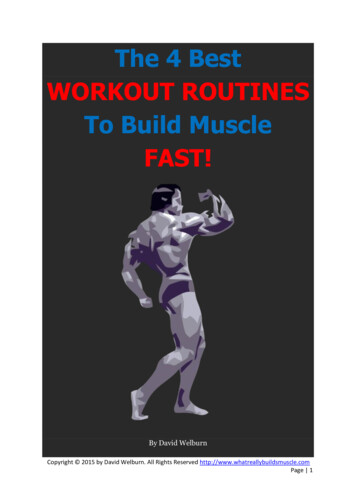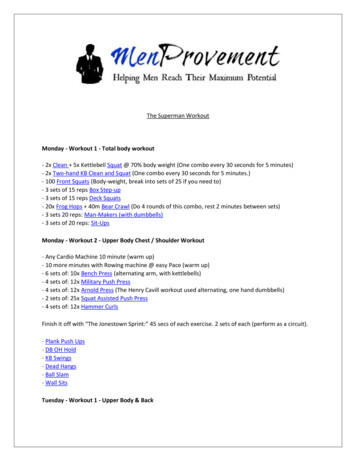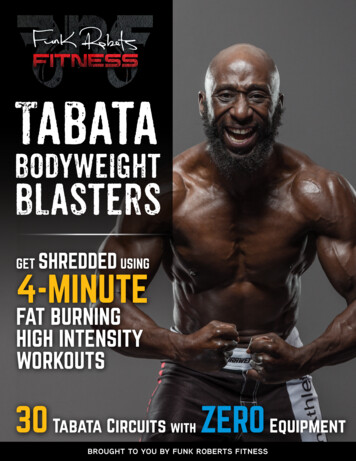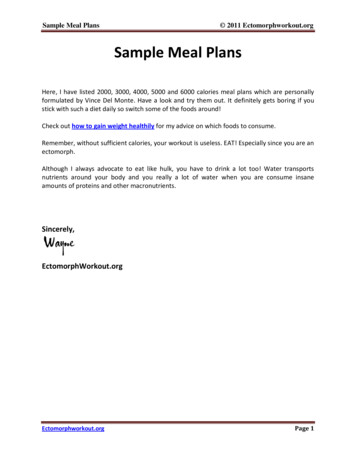
Transcription
The 4 BestWORKOUT ROUTINESTo Build MuscleFAST!By David WelburnCopyright 2015 by David Welburn. All Rights Reserved http://www.whatreallybuildsmuscle.com .Page 1
DisclaimerYou should get your doctor's approval before beginning any exercise program. Theserecommendations are not medical guidelines but are for educational purposes only.You must consult your medical professional prior to starting any of these programsor if you have any pre-existing medical condition or injury. These programs aredesigned for healthy individuals 18 years and older only. David Welburn andwhatreallybuildsmuscle.com assumes no liability and cannot be held responsible forany injuries, illnesses or personal loss caused by the utilization of this information.Please NoteYou may share this complete document with anyone you wish provided it isunaltered and all links are left intact.You may republish excerpts of up to 300 words from this booklet as long as they areaccompanied by an attribution link back to http://www.whatreallybuildsmuscle.comYou may NOT sell this information, alter it, repackage it or present it as your owncontent.Copyright 2015 by David Welburn. All Rights Reserved http://www.whatreallybuildsmuscle.com .Page 2
ContentsIntroduction4The Full Body Workout Routine6The Upper/Lower Split Routine10The Push/Pull/Legs Split15The Opposing Muscle Groups Routine18A Word about Intensity and Effort20Diet and Recovery22Recommended Programs24Supplements27Conclusion29Copyright 2015 by David Welburn. All Rights Reserved http://www.whatreallybuildsmuscle.com .Page 3
IntroductionWhen I first started training in 1976 I had no idea what I was doing. A Charles Atlascourse that had you doing “dynamic tension” calisthenics twice per day was myintroduction to the process of building muscle.But it worked quite well. I went from being one of the skinniest and weakest kids inmy year at school to one of the strongest and most athletic in a few months.Then a couple of years later I invested in a set of weights so I could train with them inmy bedroom, much to my mother’s consternation.I trained according to the instructions in the manual that came with the weight’s set.Looking back it was a perfectly reasonable beginner’s routine I guess, but I hadstarted reading all the muscle mags by that time. And then, as now, there was a lot ofmisleading information in them, which sent me down completely the wrong path.A lot of what I read talked about high volume “bodybuilder style” workout routines.And it was constantly stressed that the way to make progress was to “push throughthe pain barrier” and keep working until your muscles were completely fatigued.Then there were those in the other camp that said that this was all wrong, and thebest way to make progress for the genetically average individual was low volumeworkouts performed no more than three days per week. But again it was stressed thatyou should always train as hard as possible. Short extremely intense workouts,pushing to the point of failure (and often beyond), was what was going to put muscleon you faster than anything else.However I now know that both these approaches are wrong. Or at the very least farfrom optimal.If you are genetically average and looking to build muscle in the most effective waypossible (without the use of drugs) you can forget the bodybuilding routines thathave you training one or two body parts per day with ultra-high volume. And you canforget the very low volume “one set to failure” method as well.So how should you train to build muscle then? What will really give you the bestresults? Well, there are a number of different approaches you could take, and that’swhat this book is about.Here I will give details of the 4 best workout routines to build muscle, and I’ll giveyou examples of each of them (so there are actually more than 4 routines here).Follow the one that you feel is most appropriate to your current needs and level ofexperience, taking into account the factors mentioned, and you will make progress.Copyright 2015 by David Welburn. All Rights Reserved http://www.whatreallybuildsmuscle.com .Page 4
How much progress? Well that’s a very individual thing and is dependent on factorssuch as genetics and how well you pay attention to recovery factors such as diet andrest.But you can rest assured that you will make progress. And your eventual resultsshould be nothing short of outstanding, no matter what your genetics are like.So let’s get started Copyright 2015 by David Welburn. All Rights Reserved http://www.whatreallybuildsmuscle.com .Page 5
The Full Body Workout RoutineYou see it all the time; someone goes into the gym with little or no trainingexperience and embarks on a “20 sets per body part, 5 day per week split routine”that they read about in some muscle mag or on some website.They do chest on Monday (obviously ), back on Tuesday, legs on Wednesday,shoulders on Thursday and arms on Friday.They use mostly isolation type exercises, they train to failure on every set, and theyhave a training partner help them force out a few more reps at the end of their sets.And 6 months later they look exactly the same.Why? Simply because the way they are training is completely wrong for them (andfor the vast majority of other natural trainees for that matter).If you are a beginner you are in an unusual (and enviable) situation. For the nextseveral months you will be able to put muscle on much faster than any intermediateor advanced trainee ever could. But you need to train in the right way so you canmake the most of that.And the best way for a beginner to train is with a full body workout routineperformed three times per week.This method of training is also great for early intermediates, or anyone who has beentraining for a while but has made little progress. If you are skinny (or skinny fat) andnot very strong, you should use a full body routine – no matter how long you havebeen training.A full body workout does not need to be extremely long. In fact you can train everymajor muscle group in your body with just three movements – a squat or deadliftvariation, an upper body push and an upper body pull.You could add in an arm exercise at the end of this if you wish, but that’s about allyou need at this stage. There’ll be time to add in some other exercises later on whenyou’ve been training a while.There are a number of ways you could set up a full body routine. You could do thesame workout three times per week. Or you could do two different workouts andalternate them (this is probably the best way to start with). Or you could do threedifferent workouts, so each exercise is performed just once per week, but your wholebody is still being trained three times per week.Copyright 2015 by David Welburn. All Rights Reserved http://www.whatreallybuildsmuscle.com .Page 6
The Beginners Full Body Workout RoutineFor example, perhaps the ideal workout routine to start with is the following Workout ASquats 3 X 5 – 7Bench Press 3 X 5 – 7Bent-over Row 3 X 5 – 7Workout BDeadlift 2 X 5Overhead Press 3 X 5 – 7Chin-Ups 3 X 6 – 8(3 X 5 – 7 3 sets of 5 – 7 reps)Just alternate these two workouts over your three weekly visits to the gym. Thenwhen you’ve been training a couple of months you could add in barbell curls to theend of workout A and parallel bar dips to the end of workout B if you wish.So your routine would now look like this Workout ASquats 3 X 5 – 7Bench Press 3 X 5 – 7Bent-over Row 3 X 5 – 7Barbell Curl 2 X 8 – 10Workout BDeadlift 2 X 5Overhead Press 3 X 5 – 7Chin-Ups 3 X 6 – 8Parallel Bar Dips 2 X 8 – 10The sets listed are your work sets. You should always do a couple of warm-up setsfirst to prepare your body for the heavier work, and to reduce your risk of injury.Copyright 2015 by David Welburn. All Rights Reserved http://www.whatreallybuildsmuscle.com .Page 7
The Three Way Full Body RoutineYou can continue with either of the above routines for as long as you are makingprogress. But once you’ve been training for several months you may find you’llrecover better (and therefore make progress for longer) if you do three differentworkouts over the course of the week.So this might look something like the following MondaySquats 3 X 5 – 7Incline Bench Press 3 X 6 – 8Bent-Over Row 3 X 5 – 7Barbell Curl 2 X 8 – 10WednesdayDeadlift 2 X 5Overhead Press 3 X 5 – 7Pull-Ups 3 X 6 – 8Parallel Bar Dips 2 X 8 – 10FridayLeg Press 3 X 8 – 10Bench Press 3 X 5 – 7Cable Row 3 X 6 – 8Hammer Curls 2 X 8 – 10Whichever routine you use your main focus should be on progressing in the weightsyou are using. So when you reach the top end of the recommended rep range for allof your work sets, increase the weight a little next workout.Focus on getting stronger, especially on the big compound lifts, and you will getbigger.You can continue to use full body workouts for as long as you wish. If you are makingprogress there is no reason to change. But at some point, as you get stronger and areusing heavier weights, it will become too much to train every body part three timesper week.Copyright 2015 by David Welburn. All Rights Reserved http://www.whatreallybuildsmuscle.com .Page 8
So at this point you will want to split your body into two different parts, training onepart in one workout and the other in a separate workout. And this type of routine isthe subject of the next chapter.Copyright 2015 by David Welburn. All Rights Reserved http://www.whatreallybuildsmuscle.com .Page 9
The Upper/Lower Split RoutineOnce you are past the beginner stage and have made some decent gains you’llprobably find you’ll make better progress if you split your body into two parts andtrain each part in separate workouts.And the most logical way to do this is to use an upper/lower body split routine.In fact for the vast majority of people who are training regularly the upper/lowersplit is the very best way there is to build muscle size and strength as quickly andeffectively as possible.With an upper/lower split routine you will train your entire upper body in oneworkout and your entire lower body in another.So that means in one workout you will train chest, back, shoulders, biceps and tricepsand in the other you will train quads, hamstrings, calves, lower back and abdominals.Using this approach you could simply do two different workouts and perform each ofthem twice per week (so you’ll be training four times per week in total). Or you coulddo four different workouts – two for upper body and two for lower body. This latermethod tends to work better as it allows for improved recovery.If you can’t get to the gym four times per week however, it doesn’t matter. You cansimply alternate your four workouts over three weekly gym visits. It will still workalmost as well. In fact for older trainees (say those over 50), and for people who arevery busy or active in other areas, it could work better.The Bodybuilders Upper/Lower SplitHere’s a great example of an upper/lower body split routine that is specificallydesigned for those whose primary concern is to increase muscle size Upper Workout 1Bench Press 3 x 5 – 730 Degree Incline Dumbbell Press 2 x 8 – 10Bent-over Row 3 x 6 – 8Close Grip Pulldowns 2 x 8 – 10Seated Dumbbell Shoulder Press 3 x 8 – 10Barbell Curl 3 x 8 – 10Triceps Pressdowns 3 x 8 – 10Copyright 2015 by David Welburn. All Rights Reserved http://www.whatreallybuildsmuscle.com .Page 10
Lower Workout 1Squats 3 x 6 – 8Split Squats (Rear Foot Elevated) 2 x 10 – 12Romanian Deadlift 2 x 8 – 10Calf Raise 4 x 8 – 10Weighted Crunches 2 x 10 – 12Upper Workout 2Decline Bench Press 3 x 6 – 8Dumbbell Flyes 2 x 10 – 12Pull-Ups 3 x 6 – 8Cable Row 2 x 8 – 10Overhead Press 3 x 5 – 7Dumbbell Hammer Curls 3 x 10 – 12Overhead French Press 3 x 10 – 12Lower Workout 2Leg Press 3 x 10 – 12Back Extensions 2 x 10 – 12Leg Curls 3 x 8 – 10Seated Calf Raise 4 x 10 – 12Hanging Leg Raise 2 x 10 – 12You’ll notice that in this routine the upper body workouts are longer than the lowerbody workouts, so you’ll need to keep the pace fairly brisk with these, resting nolonger than you need to between sets, to ensure you are able to get them done in areasonable time period.The Powerbuilders Upper/Lower SplitAnd here’s a slightly different version that’s designed for those whose primaryconcern is to increase strength, but who still want to pack on as much size as possibleas well Copyright 2015 by David Welburn. All Rights Reserved http://www.whatreallybuildsmuscle.com .Page 11
Upper Workout 1Bench Press 3 x 4 – 6Bent-over Row 3 x 6 – 8Close Grip Bench Press 2 x 8 – 10Close Grip Pulldowns 2 x 8 – 10Seated Dumbbell Shoulder Press 3 x 8 – 10Barbell Curl 3 x 8 – 10Lower Workout 1Squats 3 x 4 – 6Back Extensions 2 x 10 – 12Split Squats (Rear Foot Elevated) 2 x 10 – 12Calf Raise 4 x 8 – 10Weighted Crunches 2 x 10 – 12Upper Workout 2Overhead Press 3 x 4 – 6Pull-Ups 3 x 6 – 830 Degree Incline Dumbbell Press 3 x 8 – 10Cable Row 2 x 8 – 10Parallel Bar Dips 2 x 10 – 12Dumbbell Hammer Curls 3 x 8 – 10Lower Workout 2Deadlift 2 x 5Leg Press 3 x 8 – 10Leg Curls 3 x 8 – 10Seated Calf Raise 4 x 10 – 12Hanging Leg Raise 2 x 10 – 12Copyright 2015 by David Welburn. All Rights Reserved http://www.whatreallybuildsmuscle.com .Page 12
The main focus of this program is on developing strength in the big 4 lifts (squat,bench press, deadlift and overhead press). But sufficient additional exercises andvolume are incorporated into the workouts to ensure maximum overall sizedevelopment, together with proper balance and symmetry.However, due to the fact that the upper body workouts tend to be longer than thelower body workouts in upper/lower splits, it is possible to modify the approachslightly by putting the arms (or just the biceps) in the lower body workouts. And asbiceps tend to respond better to more frequent training than most other body parts,this seems to be a particularly effective way of doing it.The Modified Upper/Lower SplitSo in this case y
The Full Body Workout Routine You see it all the time; someone goes into the gym with little or no training experience and embarks on a “20 sets per body part, 5 day per week split routine” that they read about in some muscle mag or on some website. They do chest on Monday (obviously ), back on Tuesday, legs on Wednesday,











